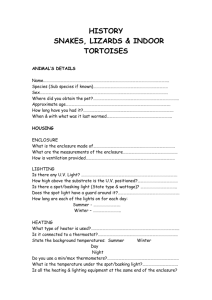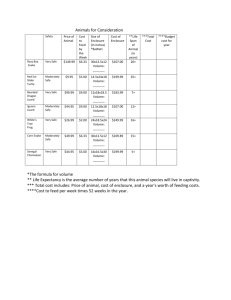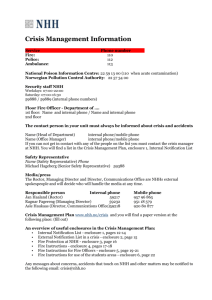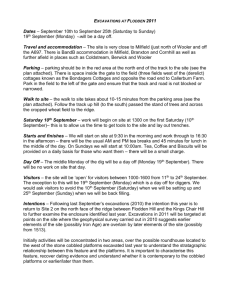Enclosure - School of Commoning
advertisement
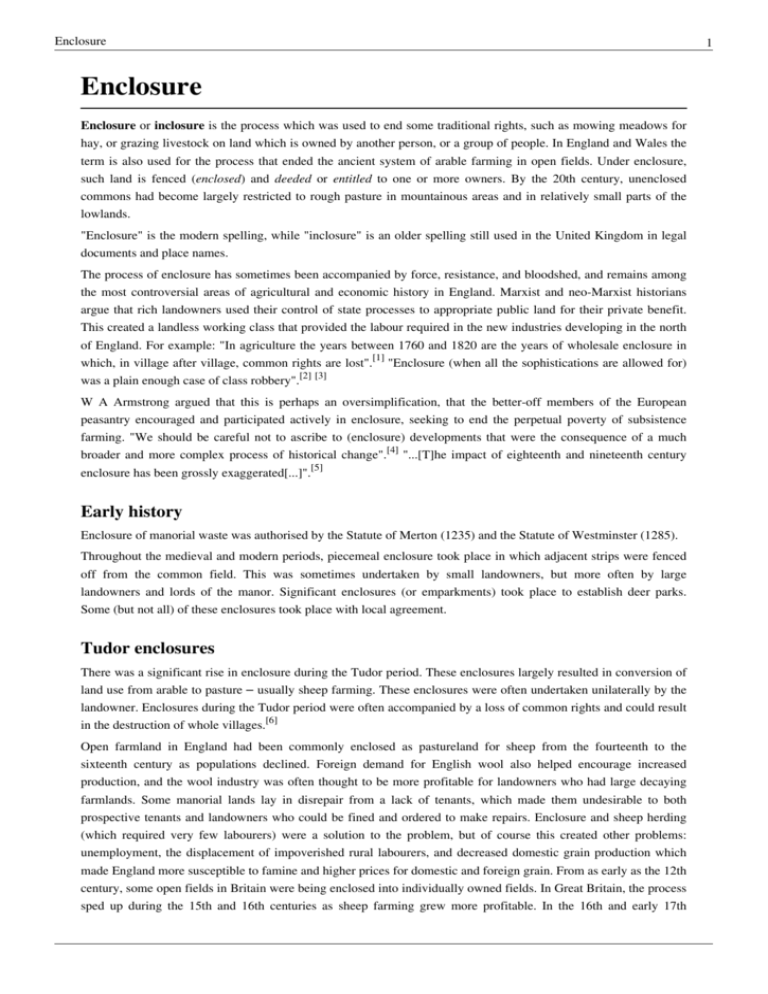
Enclosure Enclosure Enclosure or inclosure is the process which was used to end some traditional rights, such as mowing meadows for hay, or grazing livestock on land which is owned by another person, or a group of people. In England and Wales the term is also used for the process that ended the ancient system of arable farming in open fields. Under enclosure, such land is fenced (enclosed) and deeded or entitled to one or more owners. By the 20th century, unenclosed commons had become largely restricted to rough pasture in mountainous areas and in relatively small parts of the lowlands. "Enclosure" is the modern spelling, while "inclosure" is an older spelling still used in the United Kingdom in legal documents and place names. The process of enclosure has sometimes been accompanied by force, resistance, and bloodshed, and remains among the most controversial areas of agricultural and economic history in England. Marxist and neo-Marxist historians argue that rich landowners used their control of state processes to appropriate public land for their private benefit. This created a landless working class that provided the labour required in the new industries developing in the north of England. For example: "In agriculture the years between 1760 and 1820 are the years of wholesale enclosure in which, in village after village, common rights are lost".[1] "Enclosure (when all the sophistications are allowed for) was a plain enough case of class robbery".[2] [3] W A Armstrong argued that this is perhaps an oversimplification, that the better-off members of the European peasantry encouraged and participated actively in enclosure, seeking to end the perpetual poverty of subsistence farming. "We should be careful not to ascribe to (enclosure) developments that were the consequence of a much broader and more complex process of historical change".[4] "...[T]he impact of eighteenth and nineteenth century enclosure has been grossly exaggerated[...]".[5] Early history Enclosure of manorial waste was authorised by the Statute of Merton (1235) and the Statute of Westminster (1285). Throughout the medieval and modern periods, piecemeal enclosure took place in which adjacent strips were fenced off from the common field. This was sometimes undertaken by small landowners, but more often by large landowners and lords of the manor. Significant enclosures (or emparkments) took place to establish deer parks. Some (but not all) of these enclosures took place with local agreement. Tudor enclosures There was a significant rise in enclosure during the Tudor period. These enclosures largely resulted in conversion of land use from arable to pasture – usually sheep farming. These enclosures were often undertaken unilaterally by the landowner. Enclosures during the Tudor period were often accompanied by a loss of common rights and could result in the destruction of whole villages.[6] Open farmland in England had been commonly enclosed as pastureland for sheep from the fourteenth to the sixteenth century as populations declined. Foreign demand for English wool also helped encourage increased production, and the wool industry was often thought to be more profitable for landowners who had large decaying farmlands. Some manorial lands lay in disrepair from a lack of tenants, which made them undesirable to both prospective tenants and landowners who could be fined and ordered to make repairs. Enclosure and sheep herding (which required very few labourers) were a solution to the problem, but of course this created other problems: unemployment, the displacement of impoverished rural labourers, and decreased domestic grain production which made England more susceptible to famine and higher prices for domestic and foreign grain. From as early as the 12th century, some open fields in Britain were being enclosed into individually owned fields. In Great Britain, the process sped up during the 15th and 16th centuries as sheep farming grew more profitable. In the 16th and early 17th 1 Enclosure 2 centuries, the practice of enclosure was denounced by the Church and the government, particularly depopulating enclosure, and legislation was drawn up against it. But elite opinion began to turn towards support for enclosure, and rate of enclosure increased in the seventeenth century. This led to a series of government acts addressing individual regions, which were given a common framework in the Inclosure Consolidation Act of 1801. Sir Thomas More, in his 1516 work Utopia suggests that the practice of enclosure is responsible for some of the social problems affecting England at the time, specifically theft. But I do not think that this necessity of stealing arises only from hence; there is another cause of it, more peculiar to England.' 'What is that?' said the Cardinal: 'The increase of pasture,' said I, 'by which your sheep, which are naturally mild, and easily kept in order, may be said now to devour men and unpeople, not only villages, but towns; for wherever it is found that the sheep of any soil yield a softer and richer wool than ordinary, there the nobility and gentry, and even those holy men, the abbots not contented with the old rents which their farms yielded, nor thinking it enough that they, living at their ease, do no good to the public, resolve to do it hurt instead of good. They stop the course of agriculture, destroying houses and towns, reserving only the churches, and enclose grounds that they may lodge their sheep in them. The loss of agricultural labour also hurt others like millers whose livelihood relied on agricultural produce. Fynes Moryson reported on these problems in An Itinerary (1617): England abounds with corn [wheat and other grains], which they may transport, when a quarter (in some places containing six, in others eight bushels) is sold for twenty shillings, or under; and this corn not only serves England, but also served the English army in the civil wars of Ireland, at which time they also exported great quantity thereof into foreign parts, and by God's mercy England scarce once in ten years needs a supply of foreign corn, which want commonly proceeds of the covetousness of private men, exporting or hiding it. Yet I must confess, that daily this plenty of corn decreaseth, by reason that private men, finding greater commodity in feeding of sheep and cattle than in the plow, requiring the hands of many servants, can by no law be restrained from turning cornfields into enclosed pastures, especially since great men are the first to break these laws. By some accounts, 3/4ths to 9/10ths of the tenant farmers on some estates were evicted in the late medieval period. Other economic historians argue that forced evictions were probably rare. Landlords would turn to enclosure as an option when lands went unused. Anti-enclosure legislation The enclosure of common land for sheep farming and the consequent eviction of villagers from their homes and their livelihoods became an important political issue for the Tudors. Reflecting royal opposition to this practice, the anti-enclosure acts of 1489 and 1516 were aimed at stopping the waste of structures and farmland which would lead to lower tax revenues, fewer potential military conscripts for the crown, and more potential underclass rebels. The Tudor authorities were extremely nervous about how the villagers who had lost their homes would react. In the sixteenth century, lack of income made one a pauper. If one lost his home as well, he became a vagrant and vagrants were regarded (and treated) as criminals. The authorities saw a multitude of what they looked upon as vagabonds and thieves coming into existence as a result of enclosure and depopulation of villages. There were numerous acts of parliament to prevent it (or extract money from those responsible). From the time of Henry VII onwards, parliament began passing acts to stop enclosure, to limit its effects or at least to fine those who did it. The first such legislation was in 1489. Over the next 150 years, there would be a further eleven Acts of Parliament and eight Commissions of enquiry on the subject.[7] Initially, enclosure was not itself an offence, but where it was accompanied by the destruction of houses, half the profits would go to the Crown until the lost houses were rebuilt. (The 1489 act gave half the profits to the superior landlord who might not be the crown, but an act of 1536 allowed the Crown to receive this half share if the superior Enclosure landlord had not taken action.) In 1515, conversion from arable to pasture became an offence. Once again, half the profits from conversion would go to the Crown until the arable land was restored. Neither the 1515 act, nor the previous legislation was effective in stopping enclosure so in 1517, Cardinal Wolsey established a commission of enquiry to determine where offences had taken place – and to ensure the Crown received its half of the profits. Inflation and enclosure Alongside population growth, inflation was a major underlying motive for enclosure.[8] When Henry VIII arrived on the throne in 1509, the royal finances were in superb shape thanks to the miserly attitude of his father Henry VII. This soon changed, however, as Henry VIII doubled household expenditure and started costly wars against both France and Scotland. With his wealth rapidly decreasing, Henry VIII imposed a series of taxes devised by his finance minister, Thomas Wolsey. Soon the population began to tire of Wolsey's taxes and a new means of finance had to be found. In 1544, Henry came up with a new answer. He reduced the silver in minted coins by about 50%; this was repeated to a lesser extent the following year. This, combined with injection of bullion from the New World, increased the money supply within England. The increase in money supply led to inflationary pressure on prices, therefore causing a long term inflation crisis, and an economic motive for enclosures. Enclosures followed because the landowners' wealth was under threat, which encouraged the landowners to become more efficient. The debasement was not seen as a cause of inflation (and therefore enclosures) until Somerset's reign as Protector of Edward VI. Up to this point enclosures were seen as the cause of inflation, not the outcome. When Thomas Smith tried to advise Edward Seymour (The 1st Duke of Somerset) on his response to enclosure (that it was result of inflation not a cause), he was only ignored. It took till John Dudley (The 1st Duke of Northumberland)'s time as Protector for his finance minister William Cecil to realise and act on debasement to stop enclosure. Enclosure riots After 1529 or so, the problem of untended farmland disappeared with the rising population. There was a desire for more arable land along with much antagonism toward the tenant-graziers with their flocks and herds. Increased demand along with a scarcity of tillable land caused rents to rise dramatically in the 1520s to mid-century. The 1520s appear to have been the point at which the rent increases became extreme, with complaints of rack-rent appearing in popular literature, such as the works of Robert Crowley. There were popular efforts to remove old enclosures, and much legislation of the 1530s and 1540s concerns this shift. Angry tenants impatient to reclaim pastures for tillage were illegally destroying enclosures. Beginning with Kett's Rebellion in 1549, agrarian revolts swept all over the nation, and other revolts occurred periodically throughout the century. Clearly the popular rural mentality was rather medieval, the goal being to try to restore the security, stability, and functionality of the old order. However, in looking to the past, early modern commoners believed they were asserting ancient traditional and constitutional rights granted to the free and sturdy English yeoman as opposed to the enslaved and effeminate French — a contrast often drawn by 16th century writers, such as Hutchins. This emphasis on rights was to have a pivotal role in the modern era unfolding from the Enlightenment. D. C. Coleman writes that the English commons were disturbed by the loss of common rights under enclosure which might involve the right "to cut underwood, to run pigs" (40). The Midland Revolt In 1607, beginning on May Eve in Haselbech, Northamptonshire and spreading to Warwickshire and Leicestershire throughout May, riots took place as a protest against the enclosure of common land. Known as The Midland Revolt, it drew considerable support and was led by John Reynolds, otherwise known as "Captain Pouch", a tinker said to be from Desborough, Northamptonshire. He told the protestors he had authority from the King and the Lord of Heaven to destroy enclosures and promised to protect protesters by the contents of his pouch, carried by his side, which he said would keep them from all harm. (After he was captured, his pouch was opened - all that was in it was a piece of green cheese.) Thousands of people were recorded at Hillmorton, Warwickshire and at Cotesbach, Leicestershire. A curfew was imposed in the city of Leicester, as it was feared citizens would stream out of the city to join the riots. A 3 Enclosure 4 gibbet was erected in Leicester as a warning, and was pulled down by the citizens. Newton Rebellion: 8 June 1607 The Newton Rebellion was one of the last times that the peasantry of England and the gentry were in open armed conflict. Things had come to a head in early June. James I issued a Proclamation and ordered his Deputy Lieutenants in Northamptonshire to put down the riots. It is recorded that women and children were part of the protest. Over a thousand had gathered at Newton, near Kettering, pulling down hedges and filling ditches, to protest against the enclosures of Thomas Tresham. The Treshams were unpopular for their voracious enclosing of land - both the family at Newton and their more well-known Roman Catholic cousins at nearby Rushton, the family of Francis Tresham, who had been involved two years earlier in the Gunpowder Plot and had apparently died in The Tower. Sir Thomas Tresham of Rushton was known as "the most odious man in the county". The old Roman Catholic gentry family of the Treshams had long argued with the emerging Puritan gentry family, the Montagus of Boughton, about territory. Now Tresham of Newton was enclosing common land - The Brand - that had been part of Rockingham Forest. Edward Montagu, one of the Deputy Lieutenants, had stood up against enclosure in Parliament some years earlier, but was now placed by the King in the position effectively of defending the Treshams. The local armed bands and militia refused the call-up, so the landowners were forced to use their own servants to suppress the rioters on 8 June 1607. The Royal Proclamation was read twice. The rioters continued in their actions, although at the second reading some ran away. The gentry and their forces charged. A pitched battle ensued. 40-50 were killed and the ringleaders were hanged and quartered. A memorial stone to those Kettering,Northamptonshire. killed now stands at the former church of St Faith,Newton,near The Tresham family declined soon after 1607. The Montagu family went on through marriage to become the Dukes of Buccleuch, one of the largest landowners in Britain.[9] [10] Parliamentary Enclosure and open fields During the 18th and 19th centuries, enclosures were by means of local acts of Parliament, called the Inclosure Acts. These "parliamentary" enclosures consolidated strips in the open fields into more compact units, and enclosed much of the remaining pasture commons or wastes. Parliamentary enclosures usually provided commoners with some other land in compensation for the loss of common rights, although often of poor quality and limited extent. Parliamentary enclosure was also used for the division and privatisation of common wastes (in the original sense of "uninhabited places"), such as fens, marshes, heathland, downland, moors. Marxist historians have focussed on enclosure as a part of the class conflict that eventually eliminated the English peasantry and saw the emergence of the bourgoisie. From this viewpoint, the English Civil War provided the basis for a major acceleration of enclosures. The parliamentary leaders supported the rights of landlords vis-a-vis the King, whose Star Chamber court, abolished in 1641, had provided the primary legal brake on the enclosure process. By dealing an ultimately crippling blow to the monarchy (which, even after the Restoration, no longer posed a significant challenge to enclosures) the Civil War paved the way for the eventual rise to power in the 18th century of what has been called a "committee of Landlords",[11] a prelude to the UK's parliamentary system. The economics of enclosures also changed. Whereas earlier land had been enclosed in order to make it available for sheep farming, by 1650 the steep rise in wool prices had come to an end.[12] Thereafter, the focus shifted to implementation of new agricultural techniques, including fertilizer, new crops, and crop rotation, all of which greatly increased the profitability of large-scale farms.[13] The enclosure movement probably peaked from 1760 to 1832; by the latter date it had essentially completed the destruction of the medieval peasant community.[14] Enclosure Before enclosure, much of the arable land in the central region of England was organised into an open field system. Enclosure was not simply the fencing of existing holdings, but led to fundamental changes in agricultural practice. Scattered holdings of strips in the common field were consolidated to create individual farms that could be managed independently of other holdings. Prior to , rights to use the land were shared between land owners and villagers (commoners). For example, commoners would have the right (common right) to graze their livestock when crops or hay were not being grown, and on common pasture land. The land in a manor under this system would consist of • • • • • Two or three very large common arable fields Several very large common haymeadows Closes, small areas of enclosed private land such as paddocks, orchards or gardens, mostly near houses In some cases, a park around the principal house, the manor house Common waste – rough pasture land (effectively everything not in the previous categories) Note that at this time "field" meant only the unenclosed and open arable land – most of what would now be called "fields" would then have been called "closes". The only boundaries would be those separating the various types of land, and around the closes. In each of the two waves of enclosure, two different processes were used. One was the division of the large open fields and meadows into privately controlled plots of land, usually hedged and known at the time as severals. In the course of enclosure, the large fields and meadows were divided and common access restricted. Most open-field manors in England were enclosed in this manner, with the notable exception of Laxton, Nottinghamshire and parts of the Isle of Axholme in North Lincolnshire. The history of enclosure in England is different from region to region.[15] Not all areas of England had open-field farming in the medieval period. Parts of south-east England (notably parts of Essex and Kent) retained a pre-Roman system of farming in small enclosed fields. Similarly in much of west and north-west England, fields were either never open, or were enclosed early. The primary area of open field management was in the lowland areas of England in a broad band from Yorkshire and Lincolnshire diagonally across England to the south, taking in parts of Norfolk and Suffolk, Cambridgeshire, large areas of the Midlands, and most of south central England. These areas were most affected by the first type of enclosure, particularly in the more densely-settled areas where grazing was scarce and farmers relied on open field grazing after the harvest and on the fallow to support their animals. The second form of enclosure affected those areas, such as the north, the far south-west, and some other regions such as the East Anglian Fens, and the Weald, where grazing had been plentiful on otherwise marginal lands, such as marshes and moors. Access to these common resources had been an essential part of the economic life in these strongly pastoral regions, and in the Fens, large riots broke out in the seventeenth century, when attempts to drain the peat and silt marshes were combined with proposals to partially enclose them. Both economic and social factors drove the enclosure movement. In particular, the demand for land in the seventeenth century, increasing regional specialisation, engrossment in landholding and a shift in beliefs regarding the importance of "common wealth" (usually implying common livelihoods) as opposed to the "public good" (the wealth of the nation or the GDP) all laid the groundwork for a shift of support among elites to favour enclosure. Enclosures were conducted by agreement among the landholders (not necessarily the tenants) throughout the seventeenth century; enclosure by Parliamentary Act began in the eighteenth century. Enclosed lands normally could demand higher rents than unenclosed, and thus landlords had an economic stake in enclosure, even if they did not intend to farm the land directly. While many villagers received plots in the newly enclosed manor, for small landholders this compensation was not always enough to offset the costs of enclosure and fencing. Many historians believe that enclosure was an important factor in the reduction of small landholders in England, as compared to the Continent, though others believe that this process had already begun from the seventeenth and eighteenth centuries. Enclosure faced a great deal of popular resistance because of its effects on the household economies of smallholders and landless labourers. Common rights had included not just the right of cattle or sheep grazing, but also the grazing of geese, foraging for pigs, gleaning, 5 Enclosure 6 berrying, and fuel gathering. During the period of parliamentary enclosure, employment in agriculture did not fall, but failed to keep pace with the growing population.[16] Consequently large numbers of people left rural areas to move into the cities where they became labourers in the Industrial Revolution. By the end of the 20th century the process of enclosure was largely complete, in most areas just leaving a few pasture commons and village greens. Many landowners became rich through the enclosure of the commons, while many ordinary folk had a centuries-old right taken away. Land enclosure has been condemned as a gigantic swindle on the part of large landowners, and Oliver Goldsmith wrote "The Deserted Village" in 1770 deploring rural depopulation. An anonymous protest poem from the 17th century summed up the anti-enclosure feeling: They hang the man, and flog the woman, That steals the goose from off the common; But let the greater villain loose, That steals the common from the goose. Contemporary movements against enclosure • Abahlali baseMjondolo in South Africa • • • • • • • • • The Bhumi Uchhed Pratirodh Committee in India The EZLN in Mexico Fanmi Lavalas in Haiti The Homeless Workers' Movement in Brazil The Landless Peoples Movement in South Africa The Landless Workers' Movement in Brazil Movement for Justice en el Barrio in the United States of America Narmada Bachao Andolan in India The Western Cape Anti-Eviction Campaign in South Africa See also • • • • • • • • • Common-pool resource Overexploitation Das Kapital (Capital), Vol. 1, Ch. 27 Intake Political economy Primitive accumulation of capital Tragedy of the commons Utopia (book) Deserted medieval village Enclosure Britain • • • • British Agricultural Revolution Diggers Highland Clearances Lowland Clearances References • W A Armstrong, "The Influence of Demographic Factors on the Position of the Agricultural Labourer in England and Wales, c 1750–1914" [17]. The Agricultural History Review vol. 29, pp. 71–82, 1981. • Maurice Beresford, The Lost Villages of England (Sutton Publishing, revised edition, 1998) • J D Chambers & G E Mingay, The Agricultural Revolution 1750-1850 (Batsford, reprinted 1982) • W.H.B. Court, "A Concise Economic History of Britain" (Cambridge University Press, 1954) • Peter Kropotkin, Mutual Aid: A Factor of Evolution, 1902 [18] • Keith Lindley, Fenland Riots and the English Revolution, 1982 • Barrington Moore, Jr., Social Origins of Dictatorship and Democracy: Lord and Peasant in the Making of the Modern World, Boston, Beacon Press, 1966. • J.M. Neeson, Commoners: Common Right, Enclosure and Social Change in England, 1700–1820, [19], Cambridge University Press, 1993, ISBN 0-521-56774-2 • Karl Polanyi, The Great Transformation, 1944 • Leigh Shaw-Taylor, 'Parliamentary Enclosure and the Emergence of an English Agricultural Proletariat', Journal of Economic History, 2001 • Joan Thirsk, Tudor Enclosures (The Historical Association, first published in 1958 with numerous reprints) • E. P. Thompson, The Making of the English Working Class (Penguin, New Edition, 1991) Further reading Humphries, J. "Enclosures, commons rights, and women." Journal of Economic History, Vol. 50, Issue 1 (1990): 17-42. Literary references • • • • Das Kapital (Capital) by Karl Marx Das Kapital (Capital), Vol. 1, Ch. 27 [20] - 'Expropriation Of The Agricultural Population From The Land' Utopia (book) by Thomas More The Yellow Admiral by Patrick O'Brian External links • Laxton Open Field Village [21] • Enclosure as it affected an English Midlands village in the nineteenth century [22] References [1] Thompson, p 217 [2] Thompson, p. 237 [3] a comparison of the English historical enclosures with the (much later) German 19th century 'Landflucht' (Urbanization) in Friedrich Engels, Die Mark, first published version in "Die Entwicklung des Sozialismus von der Utopie zur Wissenschaft", Hottingen-Zürich 1882. Karl Marx/Friedrich Engels - Werke. (Karl) Dietz Verlag, Berlin. Band 19, 4. Auflage 1973, reprint of 1. edition 1962, Berlin/DDR. S. 315-330 [4] Chambers & Mingay, p. 104 [5] Armstrong, p. 79 7 Enclosure [6] Beresford, p. 28 [7] Beresford p. 102 et seq. [8] Thirsk p.9 [9] http:/ / www. monbiot. com/ archives/ 1995/ 02/ 22/ a-land-reform-manifesto/ [10] http:/ / en. wikipedia. org/ wiki/ Duke_of_Buccleuch [11] Moore, pp. 17, 19-29. [12] Moore., p. 7, fn. 6 [13] Moore, p. 23 [14] Moore pp. 25-29 [15] Thirsk p. 4 [16] Chambers and Mingay, p. 99 [17] http:/ / www. bahs. org. uk/ 29n2a1. pdf [18] http:/ / www. calresco. org/ texts/ mutaid7. htm [19] http:/ / www. cambridge. org/ uk/ catalogue/ catalogue. asp?isbn=0521567742 [20] http:/ / www. marxists. org/ archive/ marx/ works/ 1867-c1/ ch27. htm [21] http:/ / www. umassd. edu/ ir/ sitesmuseum/ laxton. cfm [22] http:/ / www. jjb. uk. com/ enclosure/ index. htm 8 Article Sources and Contributors Article Sources and Contributors Enclosure Source: http://en.wikipedia.org/w/index.php?oldid=362223701 Contributors: *jb, 4C, ABF, Adamsan, Ahoerstemeier, Akiyama, Alansohn, Alberto Chilosi, Anthere, Beland, Bhuston, BillMasen, Blisco, Bobo192, Boccobrock, Booyabazooka, Brett epic, Businessman332211, CanOfWorms, Canadian-Bacon, Canderson7, Chevin, Chris the speller, Cleduc, Crosbiesmith, Cybercobra, Dalf, Dardasavta, DarkArcher, Darklilac, DeadEyeArrow, Deor, Dpknauss, Dreadstar, Dust4ngel, ElTyrant, Eldredo, Eliz81, Eric-Wester, Eshan, Esperant, Fubar Obfusco, Fullerenedream, Gadfium, Gaius Cornelius, GangofOne, Glennwells, Graham87, Hebrides, Heron, Hires an editor, Holmium, Husond, Itsmejudith, Ixfd64, Ixnayonthetimmay, J.delanoy, JForget, Java13690, Jclemens, Jkelly, Joanenglish, Jonathan Hall, Kaihsu, Kenneth M Burke, King of Hearts (old account 2), Kinou, Krol:k, Lacrimosus, Lambiam, Lancevortex, Lapsed Pacifist, Latka, LiamE, Logan, Louisekasemeier, Matturn, Maury Markowitz, Mdmcginn, Mebden, Mel Etitis, MeltBanana, Michael Hardy, Miquonranger03, MrWhich, Myanw, Naturenet, Nbarth, Ncmvocalist, Nils Simon, Noetherian, Nohope, Noisy, Nortonius, Nubeli, OwenBlacker, P4k, PMLawrence, ParisianBlade, Pavel Vozenilek, Petehandsome, Peter Caffrey, Pharaoh of the Wizards, Plumbago, Polentario, Proofreader77, QueenCake, Quintote, R Lowry, RHaworth, RJFJR, RanPrieur, Ranveig, Rettetast, Richard New Forest, Rjm at sleepers, RoyBoy, Salamurai, SchfiftyThree, Scramjet42, Sean01, Sekwanele, SiGarb, Sirkad, Slocombe, Southernwood, Specter01010, Srleffler, Stephenb, Steven Walling, Steven1080, SummerWithMorons, TastyCakes, The Thing That Should Not Be, Timrollpickering, Tiptoety, Tnxman307, Toffeedog, Tom in London, Troublestarts, Ukexpat, Uthbrian, Vervin, Violetriga, Who, Wiki h4ck3r, Wizzy, X-x-charwee-x-x, Youwanner, 249 anonymous edits License Creative Commons Attribution-Share Alike 3.0 Unported http:/ / creativecommons. org/ licenses/ by-sa/ 3. 0/ 9


